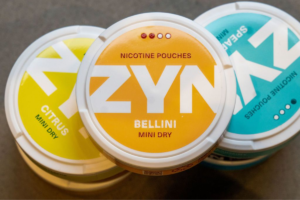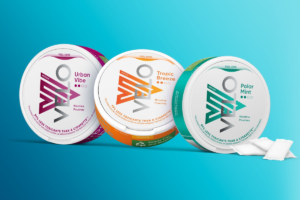Understanding Nicotine Pouch as a Nicotine Product
Comparison between nicotine pouches and traditional tobacco products
- Presence of Tobacco: Traditional tobacco products contain dried tobacco leaves that are normally smoked to deliver nicotine as well as a host of other harmful chemicals. However, in the case of Nicotine pouches, they only offer the nicotine which they get from the tobacco plant but do not contain any leaves. This is a unique approach designed to minimize exposure to carcinogenic elements usually present in tobacco combustion.
- Method of Use: Smoking is the primary purpose for which conventional tobacco products such as cigarettes and cigars were made. The intake of Nicotine pouches on the other hand involves oral fixation through placing the pouch between gum and lip with nicotine absorbed without smoke or burning involved.
- Health Risks: Combustion in this case results into release of thousands of chemicals many being identified as cancer causing agents; such is not found in Nicotine pouches because there is no combustion going on. Despite this, there have been concerns regarding how safe long term use of Nicotine Pouch is.
- Regulation and Control: Both nicotine pouches and traditional tobacco products are subject to regulatory scrutiny, though rules governing them do differ significantly across countries. Extensive research has been done on conventional tobacco products leading to strict regulation over their use, marketing and sales. They are however relatively new hence still going through processes towards having comprehensive regulations around them.
- Consumer Perception: Some users increasingly believe that nicotine pouches represent a less risky option compared to traditional cigarettes due to lack of inhaling smoke. However it should be noted that “safer” does not mean “safe” as all types of delivery using nicotine carry health risks.
The rise in popularity among former smokers
Factors including perceived health benefits, ease-of-use and satisfying nicotine cravings without smoking have contributed significantly towards making former cigarette smokers’ favorite brand masses flock into buying these brands (Public Health Ontario 2015). Smokeless options like absorbsable forms like gums will help them quit and minimize the health dangers associated with tobacco. Smoke free indications also appeal to those within smoke free areas. Gradual reduction in some nicotine level options is available to help stop smoking people. There is a lot of research on long-term effects and the efficacy of these forms as cessation tools in public health.
Tobacco-free nicotine pouch: Is it safer?
The comparison of safety between tobacco-free nicotine pouches and traditional tobacco products is complicated. It should be noted that both have nicotine, which addiction can cause cardiovascular diseases, hypertension and affect teenage brain development. Nicotine pouches do not contain tobacco thus reducing consumers’ exposure to toxic tar as well as carbon monoxide coming from smoke resulting into lowering cancer, COPD, heart disease among others (Caldwell et al., 2019). However, there are still risks to one’s health from nicotine. For effective policy formulation in public health we must conduct research so that we understand long term effects.
Can Quitting Smoking with Nicotine Pouch Reduce Cancer Risk?
Here’s how:
- Absence of Smoke: In other words, nicotine pouches do not involve burning or inhalation of smoke; hence they decrease the exposure to carcinogens in tobacco smoke like tar and carbon monoxide that are implicated in lung, throat and esophagus cancers.
- Reduced Exposure to Tobacco-Specific Nitrosamines (TSNAs): TSNAs are very strong cancer-causing agents that are found in tobacco and its smoke. Nicotine-free snus means fewer opportunities for contact with these harmful substances.
- Lower Levels of Toxic Metals and Chemicals: Whenever tobacco is burnt, a whole cocktail of toxic metals as well as chemicals enters into body. By avoiding combustion, nicotine bags might reduce the consumption of such substances associated with various cancers.
- Possibility for Safer Nicotine Delivery: Nicotine itself is addictive and there is no doubt that it causes harm but getting nicotine without the smokes from tobacco may be a safer choice for individuals who cannot stop using nicotine altogether reducing also chances of cancer related to smoking.
- Encouragement Towards Complete Cessation: To some degree, however, they can be seen as an aid towards people who want to quit smoking though its use should only serve as step towards complete cessation since this significantly reduces all cancers linked to smoking.
The Link Between Nicotine Pouch and Cancer
Scientific evidence on the risk of oral and lung cancer.
Theses concerns are addressed by new findings:
Despite tobacco absence, nicotine presence can still induce tumor growth and metastasis, especially in models of lung cancer, a 2022 Journal of Clinical Oncology research paper highlighted. This is an indication that nicotine may not entirely be harmless regardless of its mode of delivery.
Another study (2023) from the International Journal of Cancer Research explored the consequences of using long-term nicotine pouches on oral health. This resulted in increased cellular changes within the mouth which serve as precursors to development oral cancers. Even though these transformations were not as extreme as those caused by regular cigarette products, they bear a word for caution on usage.
The incidence of oral and lung cancers was compared between users who use nicotine replacement therapies (NRTs) and traditional smoking products in a meta-analysis published in American Journal Public Health. The analysis revealed statistically significant but much lower elevation in cancer rates among NRT users including nicotinell users when compared to those who smoke.
Nicotine: Cancer Related Findings from Agency for Research on Cancer
Nicotine’s carcinogenicity has been investigated through extensive reviews conducted by the Agency for Research on Cancer (IARC). Their results have identified various roles played by this chemical in tumorigenesis particularly through interaction with cell signaling cascades that can lead to tumor formation. Though devoid of the carcinogenic tar present in cigarettes alone, nicotine cannot be ruled out as far as puffiness or thickening skin cells are concerned since it may promote malignancy via manipulation signals that regulate cellular reproduction survival. It therefore follows that care should be taken when handling any form of this drug including snus according to IARC ratings.
Long term implications associated with Nicotine Pouch Use
- Oral Health Deterioration: Gum recession, tooth decay, and an increased risk of developing oral leucoplakia progressing to cancer can result from prolonged exposure to nicotine through pouches.
- Nicotine Addiction: In spite of being marketed as safe, nicotine pouches promote the dependence on nicotine thus making quitting smoking entirely quite cumbersome for addicts.
- Cardiovascular Risks: Nicotine is associated with long-term cardiovascular problems by raising heart rate and blood pressure even in cases where traditional tobacco smoking is not present.
- Potential for Cancer: Although studies are still ongoing, it has been demonstrated that nicotine affects both cell proliferation and apoptosis implying that using snus for a long time may heighten chances of developing a carcinoma similar to other forms of delivering nicotine.
- Impact on Youth: Young people may find it easier to acquire and use nicotine pouches because they think that these products are harmless. This would lead to early development of addiction to nicotine which comes with health related complications.
Health Effects and Risks of Using Nicotine Pouches
Understanding the Health Hazards of Nicotine Pouch Constituents
Nicotine pouches are non-tobacco products that have tobacco-free nicotine formulation, which may be either synthetic or herbal. While these bags are commonly advertised as less harmful, their effects on health should not be taken lightly. Oral and general health can be affected by ingredients such as nicotine, flavorings and sweeteners. It is important to investigate and comprehend these possible risks so as to make informed choices about usage.
A Comparative Study: Nicotine Pouches versus Chewing Tobacco and Cigarettes
This comparison concentrates on their content, method of consumption, and resultant health hazards.
- Content: In contrast with chewing tobacco that contains shredded tobacco leaves and cigarettes made from leaf-rolled tobacco in paper including many toxic chemicals produced during its processing by curing or combustion process; nicotine pouches exclude a tobacco leaf but contain synthetic or extracted nicotine as well as flavorings plus sweeteners.
- Method of Use: For nicotine pouches it is placed between the gum and lip where the nicotine gets absorbed via mucosal membrane within mouth. Tobacco for chewing however, entails putting leaves into your mouth then one has to chew it for nicotine release while cigarette smoking concerns inhaling the smoke containing nicotines and other substances through combustion into lungs directly.
- Health Risks: The primary hazards with regard to using nicotine pouches include addiction occasioned by excessive absorption of nicotine orally onto gums among others. However, various studies have examined links between chewing tobacco consumption and oral cancers/lesions, tooth cavities/tooth decay etc besides other oral medical difficulties resulting from placing the leaf between teeth/mucosa due to inherent chemical compounds. On the flip side, cigarettes present highest health risk such as severe respiratory illnesses (as bronchitis), lung cancer, heart disease including stroke mostly due to breathing in burnt chemical elements like tar or carbon monoxide.
- Secondhand Exposure: Unlike smoking through secondhand smoke and chewing tobacco through spit or waste products, nicotine pouches do not expose those around to any health risks.
Effect of Nicotine on Oral Health: Consideration for Gums and Lips
Irrespective of the manner in which it is delivered, nicotine has profound impacts on oral health. Insufficient blood supply to gums due to reduced flow resulting from nicotine may cause gum recession and thus make them more prone to gum diseases. In addition, the mucous membrane is irritated by nicotine causing dry mouth that increases the possibility of tooth decay and oral infections. Frequently typical are gum recession plus lip irritation since these are where the nicotine pouch concentrate making its impact felt because it is placed there. Therefore, despite relieving users of risks associated with tobacco leaf or combustion as in tobacco cigarettes, such products still do pose serious concerns on oral health.
The Role of Nicotine Replacement in Quitting Tobacco
Myths and Realities of Nicotine Pouch as a Cessation Tool
Nicotine pouches are an alternative to cigarettes for people who want to stop using tobacco, but they still contain nicotine. They may not address the problem of nicotine addiction on its own but can reduce harm associated with tobacco use.
Does it Help? Navigating Nicotine Withdrawal with Pouches
An intricate representation arises when it comes to navigating nicotine withdrawal symptoms through the aid of nicotine pouches. By providing controlled doses of nicotine, nicotine pouches can ease withdrawal symptoms so that quitting involves gradual process unlike stopping “cold turkey” immediately. Nevertheless, this path still requires strict discipline and full cessation plan management. It also raises concerns over substituting one form of nicotine delivery for another and stresses on the necessary input from healthcare providers in developing an effective program for quitting.
Evaluating the effectiveness of Nicotine Replacement Therapy (NRT) Products
Nicotine Replacement Therapy (NRT) products have been scientifically proven to increase chances of quitting smoking. Efficacy varies between individuals depending on their level of dependence as well as smoking habits which could be patches, lozenges, nasal sprays or inhalers among others. Although not typically categorized as an NRT product; it seeks to do the same by offering an alternative source of nicotine like traditional chewing gums do. Assessing how these work in relation to specific needs within a context Tobacco Cessation Program is crucially important Evidence has shown that most successful quit attempts involve a combination behavioral support and pharmacological treatment.
Safe Practices and Recommendations for Nicotine Pouch Use
Choosing the right amount of nicotine and limiting nicotine pouch use
Here are the steps to follow:
- Assess Smoking Habits: Evaluate how much you smoke in a day, depending on which kind of smoker you are. For heavy smokers, for instance, they may need NRT products with more nicotine while light smokers may do with those that have less of it.
- Consult Healthcare Providers: It is advisable to seek guidance from healthcare providers or cessation specialists who can recommend an appropriate starting dose of nicotine based on your smoking history and physiological needs.
- Adjustment Phase: Be prepared to change the level of nicotine as one progresses through stopping smoking. Gradually reducing the nicotine levels in NRT products can help wean off nicotine dependency over time.
- Continuous Monitoring: Assess your cravings and withdrawal symptoms periodically. If you notice that you have intense cravings or withdrawal symptoms, talk to your healthcare provider about adjusting your nicotine dosage.
- Timeframe for Use: Establish a clear plan for how long you would like to be using NRTs (Nicotine Replacement Therapy). Reliance on NRTs beyond this period might impede cessation efforts. Instead, set goals aimed at gradually reducing and eventually ceasing use of NRTs for ultimate complete quitting tobacco smoke that contains nicotine.
Strategies to Limit Nicotine Pouch Use
- Set Clear Usage Guidelines: Set daily limits at a specified number per day which should be maintained all along until it is down to zero in due course.
- Utilize Behavioral Techniques: Combine them with counseling or support groups as behavioral supports when putting them into practice. This way both physical and psychological aspects associated with addiction will get addressed comprehensively.
- Monitor Progress: Observe progress in relation to cessation goals including milestones achieved. Such successes should be celebrated so as not to deter further commitment.
- Seek Alternatives: Identify non-nicotine containing oral fixations such as sugar-free gum or lozenges which may offer sensory substitutes without the addition of nicotine.
By taking deliberate decisions on the choice of NRT products and establishing strategies for limiting nicotine pouch use, individuals can effectively manage their intake of nicotine to support their overall goal of quitting tobacco.
Recommendations from the American Cancer Society on Nicotine Pouches
- Consult Health Professionals: People must seek advice from health professionals before starting any NRTs so that they come up with a personal quit plan that may include using nicotine pouches as a transition tool.
- Short-term Use: When it comes to the use of these products, the period should be as short as possible not exceeding one which can encourage new dependence creation. They are meant to help you make the switch from smoking cigarettes to using safer alternatives instead.
- Comprehensive Support: Nicotine pouches should be used together with such other programs like behavioral therapy and peer support groups for comprehensive care according to ACS recommendations.
- Awareness and Education: The public should have information about risks and benefits associated with using nicotine pouches. Proper usage, potential side effects, long-term dependency avoidance measures ought to be taught in schools now.
- Regulation and Safety: The ACS recommends stricter regulation of NRTs including nicotine pouches in terms of safety and effectiveness. There is need for clear labeling and correct dosage instructions that will guide users.
Frequently Asked Questions
Q: What are nicotine pouches?
A: Nicotine pouches are a type of smokeless tobacco product that contains nicotine but does not involve smoking or chewing tobacco. They come in various flavors and are placed in the mouth between the gum and lip.
Q: Are nicotine pouches safer than smoking cigarettes?
A: While nicotine pouches do not involve inhaling smoke, which reduces some of the harm associated with smoking, they still contain nicotine, which is addictive. Long-term use may have health risks, although they are generally considered less harmful than smoking cigarettes.
Q: Do nicotine pouches increase the risk of cancer?
A: Some studies suggest that nicotine pouches may increase a person’s risk of cancer, especially oral cancer. However, more research is needed to understand the impact of nicotine pouches on cancer risks fully.
Q: Can nicotine pouches help people quit smoking?
A: Nicotine pouches are sometimes used as a smoking cessation aid by providing a source of nicotine without the harmful effects of smoking tobacco. However, it’s essential to consult a healthcare professional for guidance on how to quit smoking effectively.
Q: What is the total nicotine content in nicotine pouches?
A: The total amount of nicotine in nicotine pouches varies depending on the brand and strength. Knowing the nicotine content per pouch is essential to understand your nicotine intake.
Q: How do nicotine pouches compare to other nicotine products like vaping?
A: Nicotine pouches differ from vaping products as they do not involve inhaling vapor. Each product has risks and benefits, so it’s crucial to consider these factors when deciding on a nicotine consumption method.
Q: Are there regulations in place for nicotine pouch products?
A: Nicotine pouch products are regulated by entities such as the Food and Drug Administration (FDA) to ensure they meet safety standards. To minimize potential risks, it’s important to purchase nicotine pouches from reputable sources.
References
- The New York Times: Can Nicotine Pouches Like Zyn Harm Your Health?
- Federal Institute for Risk Assessment: Health risk assessment of nicotine pouches
- Medical News Today: Nicotine pouches: Are they safe?
- University of Houston, Department of Health and Human Services: Unveiling the Truth: Will Nicotine Pouches Cause Cancer?
- NCBI: Relationship between type of smokeless tobacco & risk
- World Health Organization: Tobacco
Recommended Reading: Pure Nicotine Pouches














